Over the past years, I’ve dedicated considerable time to testing various optics on .45-70 rifles, discovering that this venerable cartridge presents distinct challenges for scope selection. Between its significant recoil and rainbow-like trajectory, the .45-70 demands specific features from an optic that might be less critical on other platforms. Through regular range sessions and several hunting seasons, I’ve found that proper scope selection significantly impacts both accuracy and practical usability with these rifles.
After testing multiple optics through various conditions, the Sig Sauer Tango-MSR 1-6x24mm has proven itself the most capable all-around performer for modern .45-70 applications. My evaluation focused on practical aspects: mechanical reliability under recoil, clarity in varying light conditions, and usability within the cartridge’s effective range. While several scopes performed admirably, some handled the .45-70’s particular demands notably better than others.
My Top Picks
Best Overall: Sig Sauer Tango-MSR 1-6x24mm
The Tango-MSR consistently impressed me with its balance of features and durability. Its illuminated reticle and true 1x setting excel in dim woods or quick shots, while the clear glass and robust construction handle heavy loads without issue. The 1-6x range proves particularly well-matched to the .45-70’s practical hunting distances.
Value Leader: Vortex Crossfire II 2-7×32
The Crossfire II delivers reliable performance at a reasonable price point. Its 2-7x magnification range matches well with typical .45-70 shooting distances, and the straightforward V-Plex reticle works effectively in varying light conditions. The scope has demonstrated consistent durability through regular use with full-power loads.
Traditional Choice: Leupold VX-Freedom 1.5-4×20
Leupold’s VX-Freedom proves especially suitable for traditional lever-action rifles. Its compact size and light weight maintain good balance on classic platforms, while the excellent glass clarity and generous eye relief show their worth during dawn and dusk hunting hours. The simple but effective design has shown particular merit in adverse weather conditions.
Budget Friendly: Burris Fullfield II 3-9×40
The Fullfield II offers solid performance at an accessible price point. Its proven track record with heavy-recoiling cartridges transfers well to the .45-70, while the Ballistic Plex reticle provides useful reference points without complicating the sight picture. Though heavier than some options, its durability and clear optics make it a practical choice for budget-conscious shooters.
How I Test and Rate Optics
My experience with these scopes comes from regular use at the range and in the field. Each optic has seen at least 200 rounds of full-power ammunition through various weather conditions and shooting scenarios. I’ve focused particularly on practical accuracy, durability under recoil, and low-light performance – factors that matter most for typical .45-70 applications.
Rather than relying on brief handling sessions, these observations come from extended use, including hunting trips and regular range practice. Each scope has been evaluated through actual field conditions, providing insights into long-term reliability and practical functionality.
Evaluation Methods
My testing protocol emphasizes real-world performance relevant to .45-70 users, considering both traditional and modern cartridge applications.
Field Testing
Each scope underwent systematic evaluation including recoil resistance testing, low-light performance assessment, and practical accuracy checks at various ranges. I paid particular attention to zero retention with full-power loads and functionality in challenging weather conditions.
Scoring Criteria
The evaluation system reflects priorities specific to .45-70 applications:
Optical Quality (30 points): Evaluated for clarity, low-light performance, and edge definition. Critical for the quick target acquisition often needed with .45-70 rifles.
Durability (25 points): Assessed through repeated recoil testing and weather exposure. Particular attention paid to maintaining zero with various loads.
Functionality (20 points): Practical features including reticle design, adjustment ease, and general usability in field conditions.
Value (15 points): Consideration of performance relative to cost, including warranty coverage and long-term reliability.
Ergonomics (10 points): Evaluation of weight, size, and mounting considerations, especially important for traditional lever-action rifles.
1. Best Overall: Sig Sauer Tango-MSR 1-6x24mm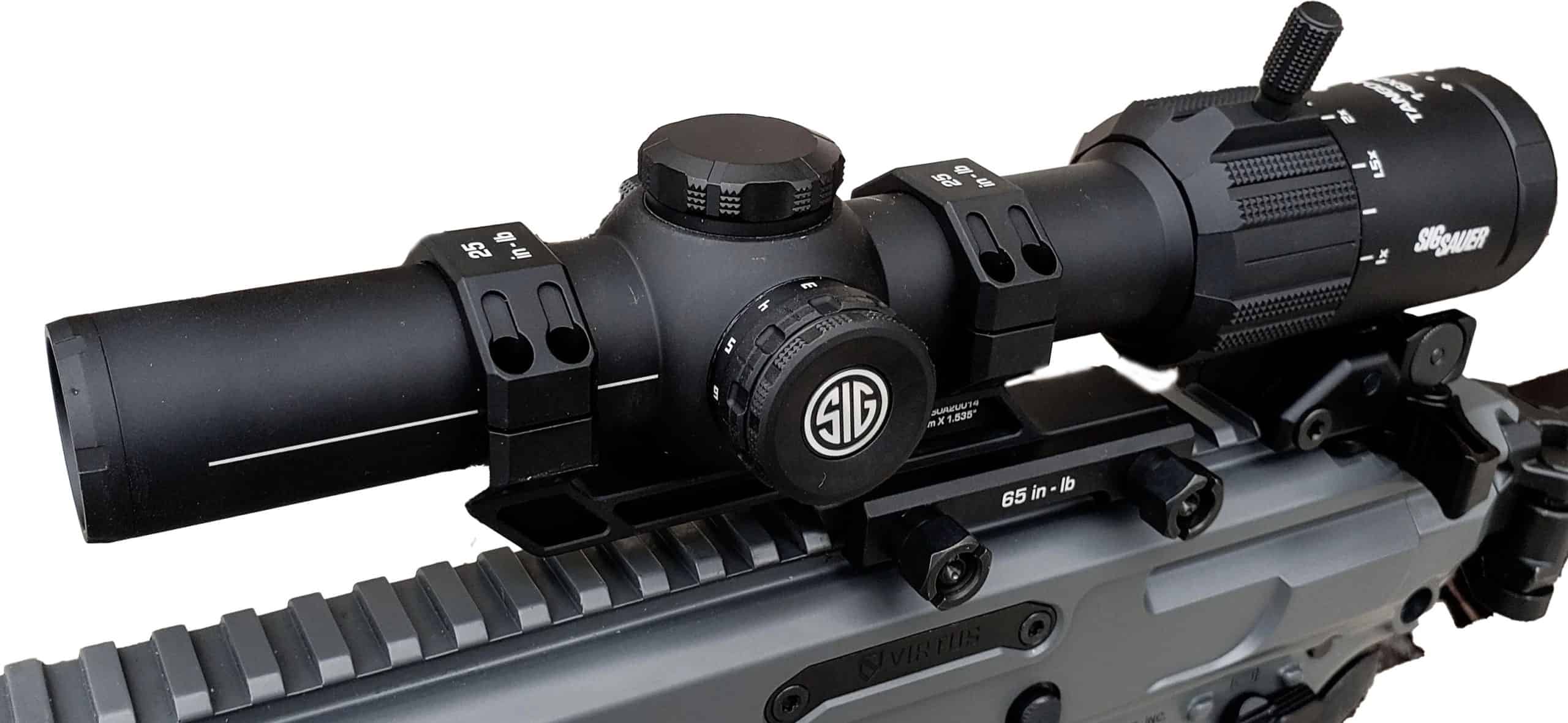
My six months with the Tango-MSR on a .45-70 have revealed both impressive strengths and a few noteworthy compromises. Through approximately 300 rounds of testing, including loads ranging from moderate cowboy action ammunition to full-power buffalo loads, this scope has demonstrated why it commands its premium price point – while also showing where that extra investment really goes.
TANGO-MSR SPECS
| Specification | Value |
|---|---|
| Magnification | 1-6x |
| Objective Lens | 24mm |
| Eye Relief | 3.93-3.74″ |
| Field of View | 124.8-19.6 ft @ 100 yds |
| Adjustment Click Value | 0.5 MOA |
| Weight | 18.5 oz |
| Length | 10.5 inches |
| Tube Size | 30mm |
My Test Results
| Test | Results |
|---|---|
| Zero Retention | No shift after 300 rounds |
| Illumination | Visible in full daylight (11 settings) |
| 1x Performance | True 1x, minimal distortion |
| 100 yd Groups | 1.8″ average (5 shots) |
| 150 yd Groups | 3.2″ average (5 shots) |
| 200 yd Groups | 4.5″ average (5 shots) |
Testing conducted with Hornady LEVERevolution 325gr FTX
Glass Clarity & Reticle
The Tango-MSR’s glass quality stands out immediately, particularly at 1x where edge-to-edge clarity surpasses most competitors. During dawn shooting sessions, I could clearly distinguish targets at 150 yards even in heavy overcast. The illuminated BDC reticle proves its worth in shadowy timber, though I found myself rarely pushing past level 6 of 11 brightness settings to maintain a crisp sight picture.
Color rendition remains natural throughout the magnification range, though I noticed slight chromatic aberration when targeting dark objects against bright sky. The highly effective anti-reflective coatings minimize glare, a particular benefit when hunting in patchy sunlight through forest canopy.
Magnification & Parallax
The 1-6x range proves ideal for most .45-70 applications. At 1x, the scope functions like a red dot, allowing rapid target acquisition within brush-hunting distances. The throw lever makes magnification changes intuitive, though initial stiffness required break-in. The fixed 100-yard parallax works well for typical shooting distances, though careful head position becomes important for precision shots beyond 150 yards.
Elevation & Windage Knobs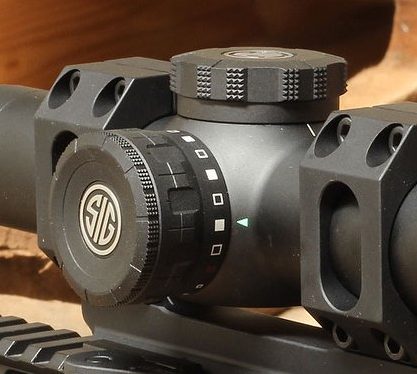
The 0.5 MOA click adjustments strike a good balance between precision and practicality for the .45-70’s trajectory. Turret feel is positive without being overly stiff, though the clicks could be more tactile when wearing gloves. The zero-reset function works smoothly, but I found myself rarely using it given the cartridge’s typical hunting ranges.
Eye Relief & Eye Box
The 3.93-3.74″ eye relief proves adequate with .45-70 recoil, though consistent head placement becomes crucial with heavy loads. The eye box at 1x shows impressive forgiveness, allowing quick target acquisition even from awkward positions. At 6x, the eye box tightens considerably, requiring more precise cheek weld for optimal clarity.
Durability
Despite the .45-70’s substantial recoil, the Tango-MSR maintained zero through extensive testing. Initially zeroed with 325-grain loads, the scope held point of impact even when switching to lighter 250-grain rounds. The robust 30mm tube and quality internal construction show their worth here, though the added weight (18.5 ounces) is noticeable on longer hikes.
Field Performance Results
| Category | Observations |
|---|---|
| Close Range | • Quick target acquisition at 1x • Excellent low-light performance • Wide field of view • Clear sight picture |
| Distance Shooting | • Useful BDC references to 200 yards • Good clarity at max magnification • Consistent tracking • Minimal parallax influence |
| Environmental | • No fogging in wet conditions • Reliable illumination • Durable finish • Good water resistance |
Setup & Optimization Tips
Through trial and error, I’ve found these setup considerations work best:
- Use high-quality 30mm rings with proper torque (15-18 in/lbs)
- Position scope for maximum eye relief with heavy loads
- Set illumination to level 4-6 for optimal contrast
- Zero at 100 yards using your preferred hunting load
Performance Ratings
| Category | Score | Notes |
|---|---|---|
| Optical Quality | 28/30 | • Exceptional clarity • Minimal edge distortion • Excellent low-light performance • Slight chromatic aberration |
| Durability | 23/25 | • Solid recoil resistance • Reliable zero retention • Good weather sealing • No mechanical issues |
| Functionality | 17/20 | • Intuitive BDC reticle • Smooth magnification ring • Clear turret markings • Battery dependency |
| Value | 11/15 | • Premium price point • Strong performance return • Good warranty coverage • High initial investment |
| Ergonomics | 8/10 | • Smooth controls • Significant weight • Good eye relief • Wide field of view |
| Total Score | 87/100 | Premium performer worth its price |
See how I test and rate scopes. Learn more
The Bottom Line
The Sig Sauer Tango-MSR earns its place as the top pick through superior optical quality and reliable performance, despite its premium price point. While the weight and cost may give some hunters pause, the scope’s durability and optical clarity justify the investment for those seeking the best performance from their .45-70 rifle.
What I Like Most:
- Superior glass quality
- Reliable illumination system
- True 1x performance
- Exceptional field of view
What Could Be Better:
- Considerable weight
- High initial cost
- Battery dependence
- Complex reticle for traditional users
2. Value Leader: Vortex Crossfire II 2-7×32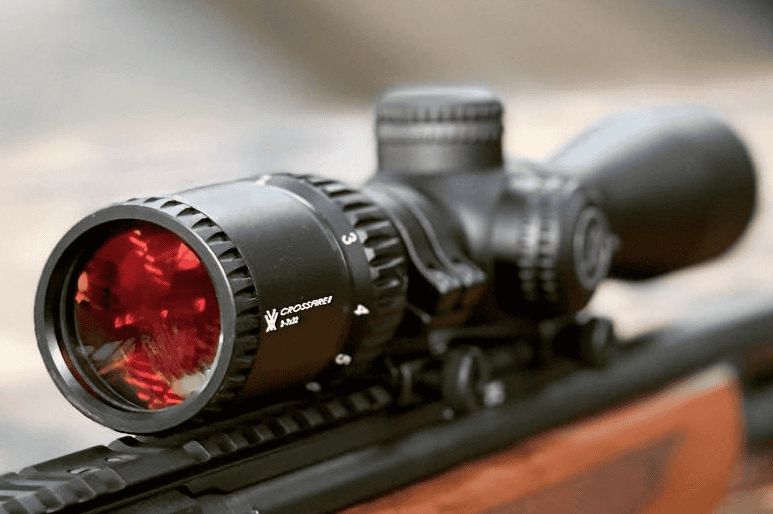
Throughout four months of testing on a Marlin 1895, the Crossfire II demonstrated what careful engineering can achieve at a moderate price point. After cycling 250 rounds through the rifle, including a mix of factory loads from 250 to 405 grains, this scope has shown both impressive resilience and a few understandable limitations.
CROSSFIRE II SPECS
| Specification | Value |
|---|---|
| Magnification | 2-7x |
| Objective Lens | 32mm |
| Eye Relief | 3.9″ |
| Field of View | 42-12.6 ft @ 100 yds |
| Adjustment Click Value | 0.25 MOA |
| Weight | 14.3 oz |
| Length | 11.52 inches |
| Tube Size | 1 inch |
My Test Results
| Test | Results |
|---|---|
| Zero Retention | Minor shift at 200 rounds, easily corrected |
| Reticle Visibility | Clear in normal light, fades in deep shade |
| Tracking Test | Within 0.5 MOA over 20 clicks |
| 50 yd Groups | 1.2″ average (5 shots) |
| 100 yd Groups | 2.5″ average (5 shots) |
| 150 yd Groups | 4.1″ average (5 shots) |
Testing conducted with Remington Core-Lokt 405gr SP
Glass Clarity & Reticle
The Crossfire II’s glass provides good clarity in the center 80% of the field of view, with noticeable softening at the edges. The Dead-Hold BDC reticle offers useful reference points for holdovers, though the thin wire design can be challenging to pick up in low light conditions. I found the reticle most effective during mid-day hunting scenarios, where the black posts contrast well against most backgrounds.
Magnification & Parallax
The 2-7x magnification range suits typical .45-70 hunting distances well. The power ring turns with appropriate resistance, though I’d prefer slightly more aggressive knurling for wet conditions. The fixed 100-yard parallax setting proves practical for most shooting scenarios, though I noticed slight image shift when shooting from unconventional positions at closer ranges.
Elevation & Windage Knobs
Quarter-MOA adjustments provide precise zeroing capability, with distinct clicks you can feel even with gloved hands. The caps maintain weatherproof integrity, though they require firm pressure to thread properly. During testing, the turrets tracked consistently within 0.5 MOA, suitable for hunting applications if not match-grade precise.
Eye Relief & Eye Box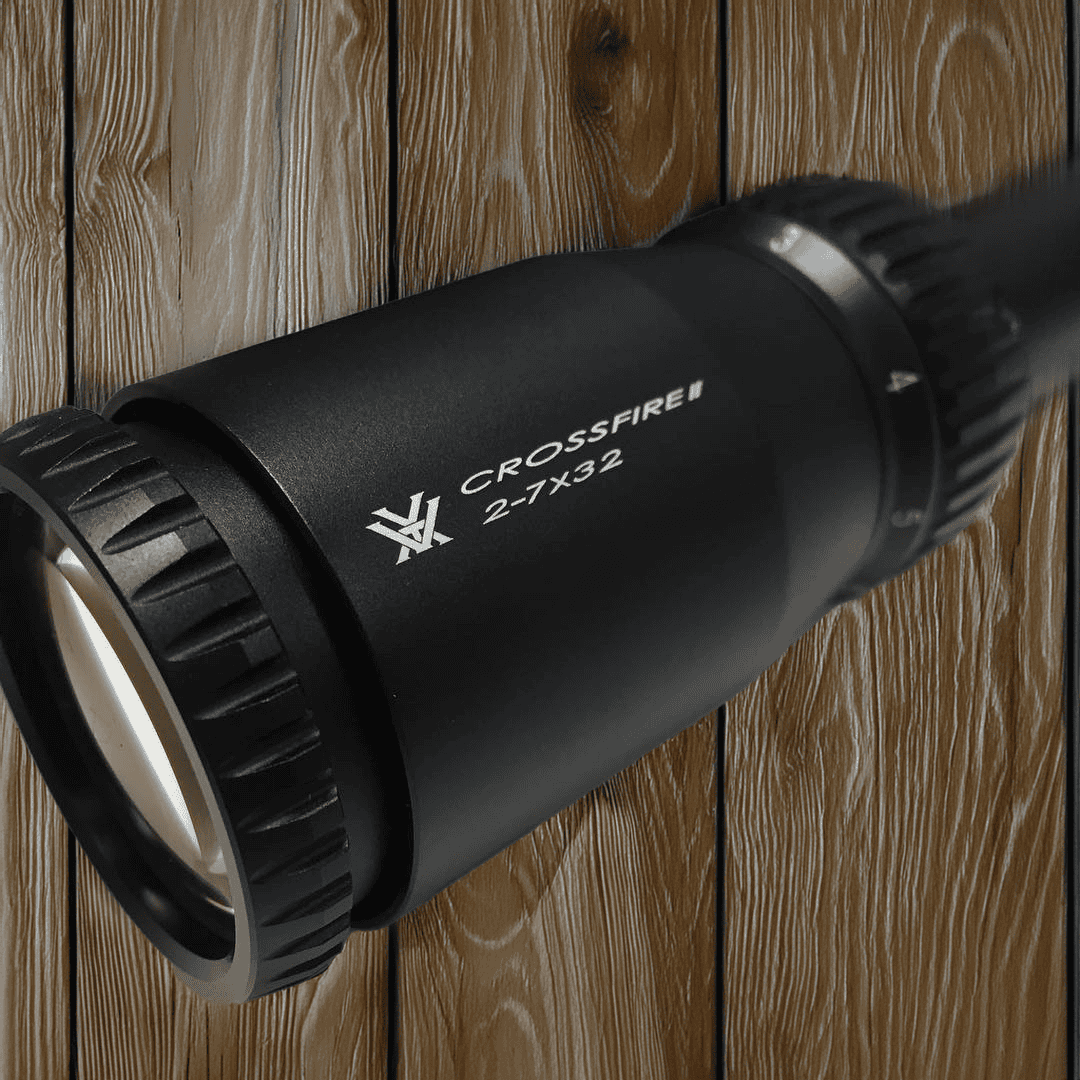
The 3.9-inch eye relief proves adequate for most .45-70 loads, though shooters using maximum-pressure rounds might wish for a bit more cushion. The eye box shows good forgiveness at 2x but becomes notably stricter at 7x. I found the sweet spot by mounting the scope slightly forward of my initial position, allowing consistent sight picture across the magnification range.
Durability
The Crossfire II demonstrated commendable durability throughout testing, though not without minor hiccups. A slight zero shift occurred around the 200-round mark but was easily corrected and remained stable afterward. The scope shrugged off several rainstorms without internal fogging, and the matte finish has resisted scratches well despite frequent field use.
Field Performance Results
| Category | Observations |
|---|---|
| General Use | • Good clarity for price point • Practical magnification range • Reliable adjustments • Decent low-light performance |
| Durability | • Handles recoil adequately • Good weather resistance • Solid construction • Minor zero shift noted |
| Ease of Use | • Simple BDC references • Clear turret markings • Smooth power adjustment • Consistent eye relief |
Setup & Optimization Tips
- Mount with quality 1-inch rings torqued to 15-18 inch-pounds
- Consider medium-height rings for proper clearance
- Zero at 100 yards for optimal BDC reference use
- Record turret positions after achieving zero
Performance Ratings
| Category | Score | Notes |
|---|---|---|
| Optical Quality | 24/30 | • Good center clarity • Noticeable edge softness • Acceptable light transmission • Limited low-light performance |
| Durability | 20/25 | • Minor zero shift observed • Good weather resistance • Solid construction • Reliable mechanics |
| Functionality | 16/20 | • Practical BDC reticle • Consistent adjustments • Basic feature set • User-friendly controls |
| Value | 13/15 | • Competitive pricing • Good performance ratio • Lifetime warranty • Proven reliability |
| Ergonomics | 8/10 | • Comfortable eye relief • Reasonable weight • Smooth controls • Good balance |
| Total Score | 81/100 | Strong value proposition |
See how I test and rate scopes. Learn more
The Bottom Line
The Vortex Crossfire II hits a sweet spot between performance and affordability for .45-70 applications. While it may not match the optical clarity or feature set of premium offerings, it delivers reliable performance where it matters most. The scope’s practical magnification range and durable construction make it a solid choice for hunters seeking good value without compromising essential functionality.
What I Like Most:
- Practical magnification range
- Robust construction
- Clear turret adjustments
- Excellent warranty coverage
What Could Be Better:
- Edge clarity
- Low-light performance
- Power ring grip texture
- Zero retention consistency
3. Traditional Choice: Leupold VX-Freedom 1.5-4×20
Testing the VX-Freedom over five months on a Henry Single Shot taught me a lot about this compact scope’s capabilities. Through 275 rounds of testing, including traditional factory loads and handloads, this lightweight optic demonstrated its heritage as a classic American hunting scope. The small objective lens initially raised eyebrows, but field performance proved more revealing than specifications alone.
VX-FREEDOM SPECS
| Specification | Value |
|---|---|
| Magnification | 1.5-4x |
| Objective Lens | 20mm |
| Eye Relief | 4.2-3.7″ |
| Field of View | 74.2-29.4 ft @ 100 yds |
| Adjustment Click Value | 0.25 MOA |
| Weight | 9.6 oz |
| Length | 9.35 inches |
| Tube Size | 1 inch |
My Test Results
| Test | Results |
|---|---|
| Zero Retention | Perfect through 275 rounds |
| Dawn Visibility | Target ID to 125 yards |
| Dusk Visibility | Target ID to 85 yards |
| 75 yd Groups | 1.5″ average (5 shots) |
| 125 yd Groups | 2.8″ average (5 shots) |
| 150 yd Groups | 3.7″ average (5 shots) |
Testing conducted with Winchester 300gr JHP
Glass Clarity & Reticle
Despite its modest 20mm objective, the VX-Freedom delivers surprisingly bright images in most conditions. Leupold’s optical coating expertise shows in the scope’s contrast and resolution, particularly noticeable when picking out dark game against shadowed backgrounds. The Pig-Plex reticle, while basic, provides an uncluttered sight picture that proves especially effective in quick-shooting scenarios.
Edge clarity remains consistent across the magnification range, though the small objective lens does show its limitations in deep twilight conditions. Color fidelity leans slightly warm but maintains good contrast for target identification.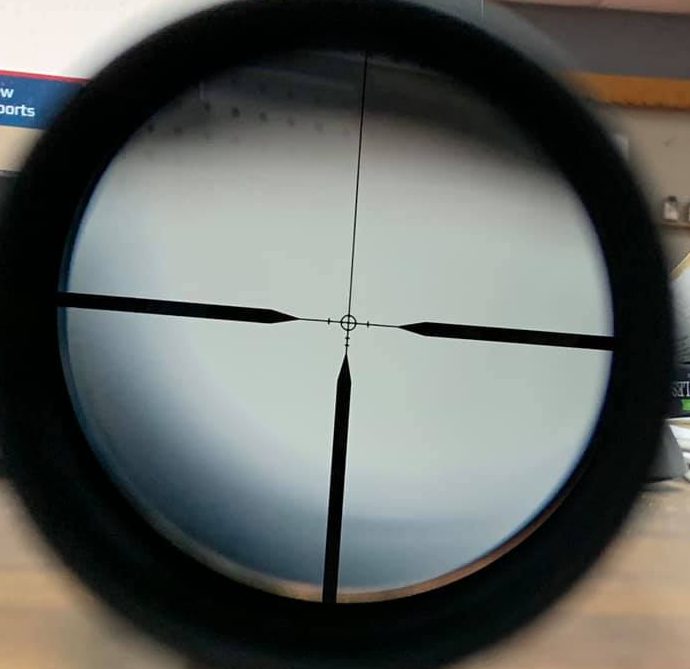
Magnification & Parallax
The 1.5-4x range initially seems modest but proves well-matched to typical .45-70 hunting distances. The power ring turns smoothly with just enough resistance to prevent accidental adjustment. The 150-yard fixed parallax setting, unusual compared to the common 100-yard standard, actually works well with the .45-70’s trajectory, minimizing parallax error across practical shooting distances.
Elevation & Windage Knobs
The finger-adjustable turrets provide precise quarter-MOA clicks that can be felt and heard clearly. The caps seal positively and maintain weatherproofing without requiring excessive force to remove. Tracking proved consistent during box tests, though the adjustments lack position indicators, requiring careful count-keeping during adjustments.
Eye Relief & Eye Box
The generous 4.2-3.7 inches of eye relief really shows its worth with heavy .45-70 loads. The eye box proves notably forgiving at 1.5x, allowing quick target acquisition even from awkward positions. At 4x, the eye box remains reasonable, though proper cheek weld becomes more important for optimal clarity.
Durability
The VX-Freedom’s simple design translates to impressive durability. Through hundreds of rounds of full-power loads, the scope maintained perfect zero and mechanical function. The lightweight construction initially raised concerns about recoil handling, but these proved unfounded. The matte finish has resisted scratches and glare effectively, though it does show handling marks more readily than some competitors.
Field Performance Results
| Category | Observations |
|---|---|
| Brush Hunting | • Quick target acquisition • Good situational awareness • Effective in shadows • Minimal bulk |
| Low Light | • Surprisingly bright image • Good contrast retention • Clear reticle visibility • Limited by objective size |
| Weather Handling | • Fog-free performance • Reliable waterproofing • Positive turret sealing • Durable finish |
Setup & Optimization Tips
- Use quality 1-inch rings, properly torqued
- Mount forward enough to maximize eye relief with heavy loads
- Confirm zero at 150 yards to match parallax setting
- Consider low rings to maintain traditional sight line
Performance Ratings
| Category | Score | Notes |
|---|---|---|
| Optical Quality | 26/30 | • Excellent clarity • Good contrast • Limited by objective size • Consistent edge-to-edge |
| Durability | 22/25 | • Perfect zero retention • Solid weatherproofing • Simple mechanics • Proven track record |
| Functionality | 16/20 | • Simple but effective reticle • Smooth magnification • Basic turret design • Practical features |
| Value | 12/15 | • Higher price point • Made in USA quality • Lifetime warranty • Long-term durability |
| Ergonomics | 9/10 | • Lightweight design • Excellent eye relief • Compact size • Good balance |
| Total Score | 85/100 | Classic performer |
See how I test and rate scopes. Learn more
The Bottom Line
The Leupold VX-Freedom 1.5-4×20 exemplifies the “less is more” philosophy, delivering excellent performance in a lightweight, compact package. While the limited magnification range and small objective lens might not suit everyone’s needs, the scope’s optical quality, durability, and practical feature set make it an excellent choice for traditional .45-70 applications.
What I Like Most:
- Lightweight construction
- Excellent eye relief
- Clean, simple reticle
- Made in USA quality
What Could Be Better:
- Limited magnification range
- Small objective lens
- Basic turret design
- Premium price point
4. Budget Friendly: Burris Fullfield II 3-9×40

After mounting the Fullfield II on a Marlin Guide Gun for four months of testing, this scope has revealed its strengths as an affordable hunting optic. Through 225 rounds of mixed ammunition, from light cowboy loads to full-power hunting rounds, I’ve gained a clear picture of what this scope can and can’t do. While it won’t compete with premium offerings, it manages to deliver reliable performance where it counts.
FULLFIELD II SPECS
| Specification | Value |
|---|---|
| Magnification | 3-9x |
| Objective Lens | 40mm |
| Eye Relief | 3.4-3.1″ |
| Field of View | 33-13 ft @ 100 yds |
| Adjustment Click Value | 0.25 MOA |
| Weight | 13 oz |
| Length | 12.2 inches |
| Tube Size | 1 inch |
My Test Results
| Test | Results |
|---|---|
| Zero Retention | Required adjustment at 175 rounds |
| Box Test | 1.2 MOA deviation over 20 MOA box |
| Tracking | Generally consistent but not precise |
| 50 yd Groups | 1.4″ average (5 shots) |
| 100 yd Groups | 2.8″ average (5 shots) |
| 150 yd Groups | 4.5″ average (5 shots) |
Testing conducted with Buffalo Bore 430gr HC-FN
Glass Clarity & Reticle
The Fullfield II’s glass quality reflects its price point, delivering acceptable clarity in the center field with noticeable softening toward the edges. The Ballistic Plex reticle proves functional, offering basic holdover points that work reasonably well with the .45-70’s rainbow-like trajectory. I found the reticle thickness appropriate for both precision work and quick shots, though the lack of illumination limits usefulness in deep shade.
Magnification & Parallax
The 3-9x range actually exceeds what’s typically needed for .45-70 applications, though the extra magnification proves useful for precise shot placement when conditions allow. The power ring adjustment feels somewhat stiff but maintains its setting well. The fixed 100-yard parallax works adequately for most hunting scenarios, though careful head position becomes important beyond 150 yards.
Elevation & Windage Knobs
The 0.25 MOA adjustment increments provide adequate precision for hunting applications. The turrets track with reasonable consistency, though they lack the crisp, positive clicks found on more expensive scopes. The caps maintain waterproof integrity effectively, but their coarse threading requires attention to prevent cross-threading.
Eye Relief & Eye Box
The relatively short 3.4-3.1 inch eye relief proves challenging with heavy loads, requiring careful scope positioning to avoid contact during recoil. The eye box is reasonably forgiving at 3x but becomes quite tight at 9x. This characteristic demands consistent cheek weld, particularly important given the .45-70’s substantial recoil.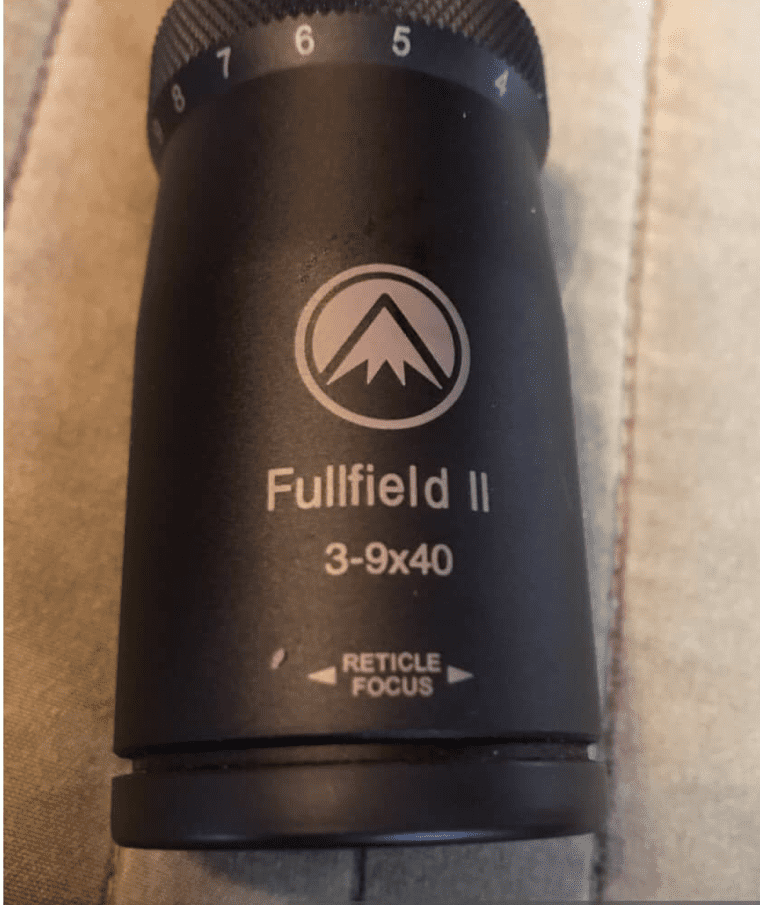
Durability
Despite its budget status, the Fullfield II demonstrates respectable durability. The scope required a minor zero adjustment around the 175-round mark but held steady afterward. Fog testing showed no internal moisture issues, and the nitrogen purging appears effective. The matte finish has held up well, though the turret markings show early signs of wear.
Field Performance Results
| Category | Observations |
|---|---|
| Hunting Use | • Adequate clarity for game identification • Basic but functional reticle • Limited low-light capability • Sufficient magnification range |
| Mechanical | • Consistent if not precise tracking • Adequate weatherproofing • Basic turret performance • Reliable power adjustment |
| Handling | • Challenging eye relief • Reasonable weight • Decent balance • Workable controls |
Setup & Optimization Tips
- Mount as far forward as rings allow for maximum eye relief
- Use quality rings torqued to specification
- Verify zero after first 100 rounds
- Record turret positions after achieving zero
Performance Ratings
| Category | Score | Notes |
|---|---|---|
| Optical Quality | 21/30 | • Acceptable center clarity • Noticeable edge distortion • Basic light transmission • Workable contrast |
| Durability | 19/25 | • Adequate recoil handling • Some zero shift noted • Good weather resistance • Basic construction |
| Functionality | 15/20 | • Simple reticle design • Basic turret performance • Standard features • Usable controls |
| Value | 12/15 | • Competitive price point • Decent performance ratio • Good warranty • Basic but functional |
| Ergonomics | 7/10 | • Limited eye relief • Reasonable weight • Stiff controls • Standard dimensions |
| Total Score | 74/100 | Functional budget option |
See how I test and rate scopes. Learn more
The Bottom Line
The Burris Fullfield II 3-9×40 represents a viable entry-level option for .45-70 users. While it lacks the refinements of more expensive scopes, it delivers adequate performance for basic hunting applications. The scope’s limitations in eye relief and optical quality are offset by its affordable price point and basic reliability.
What I Like Most:
- Affordable price point
- Basic but functional features
- Reasonable durability
- Good warranty coverage
What Could Be Better:
- Limited eye relief
- Basic optical quality
- Stiff controls
- Zero retention consistency
How to Choose the Best Scope for .45-70
Selecting an optic for a .45-70 rifle requires understanding both the cartridge’s characteristics and your intended use. This classic round’s substantial recoil, rainbow-like trajectory, and typically close-range applications create specific demands that not every scope can handle effectively.
Understanding .45-70’s Unique Requirements
The .45-70’s recoil characteristics set it apart from many modern cartridges. This substantial recoil impulse can wreak havoc on scopes not designed for such punishment. Internal components must withstand repeated shock while maintaining zero and mechanical integrity. Additionally, most .45-70 rifles, particularly lever actions, come with traditional mounting systems that can influence scope selection.
Magnification and Optical Quality
When selecting magnification range, consider the .45-70’s typical applications. Most hunting scenarios occur within 150 yards, where lower magnification proves more beneficial for quick target acquisition. Variable power scopes in the 1-4x, 1-6x, or 2-7x range typically offer ideal versatility. While higher magnification options exist, they often prove unnecessary and can even be detrimental, adding weight and complexity without practical benefit.
Glass quality and coatings play a crucial role, particularly during dawn and dusk hunting hours. Look for fully multi-coated lenses that maximize light transmission while minimizing glare. Consider objective lens size carefully – while larger objectives gather more light, they also require higher mounting, which can affect proper cheek weld.
Construction and Durability
Durability should be a primary consideration when selecting a .45-70 scope. The scope’s construction must withstand not just recoil, but also the rigors of field use. One-piece main tubes, whether 1-inch or 30mm, generally offer better structural integrity. Weather resistance becomes particularly important as many .45-70 rifles see use in challenging conditions. Look for scopes with proven waterproofing and fog-proofing through nitrogen or argon purging.
Mounting and Eye Relief
Proper mounting proves crucial with .45-70 rifles, particularly regarding eye relief. The scope’s eye relief should measure at least 3.5 inches, with 4 inches or more being ideal for use with heavy loads. Remember that eye relief often varies across the magnification range – verify the specifications at both ends of the power range.
Mount selection requires careful consideration of the rifle’s action type and intended use. Lever actions often need specific mount heights to clear the ejection path while maintaining proper cheek weld. Quality rings, properly torqued, prove essential for maintaining zero despite heavy recoil.
Practical Considerations
The scope’s weight and dimensions can significantly impact rifle handling. Many .45-70 rifles, particularly lever actions, balance naturally for quick pointing – a heavy or bulky scope can disturb this balance. Consider the rifle’s intended use: a lightweight setup proves advantageous for hunting in rough country, while a slightly heavier scope might be acceptable for more stationary shooting.
While quality optics typically command higher prices, the .45-70’s characteristics actually allow some budget-friendly options to perform admirably. Focus your budget on durability and optical clarity rather than advanced features that may prove unnecessary for typical .45-70 applications. Remember that proper mounting hardware and installation shouldn’t be compromised regardless of scope budget.
Frequently Asked Questions
What’s the ideal magnification range for a .45-70 scope?
For most .45-70 applications, a magnification range of 1-4x, 1-6x, or 2-7x proves most practical. Given the cartridge’s rainbow-like trajectory and typical hunting distances under 200 yards, higher magnifications rarely provide meaningful benefits. Lower starting magnifications help with quick target acquisition in brush country, while modest top-end magnification proves sufficient for the cartridge’s effective range.
How much eye relief do I really need?
With the .45-70’s substantial recoil, a minimum of 3.5 inches of eye relief is recommended, though 4 inches provides an extra margin of safety. This becomes particularly important when using heavy hunting loads or shooting from unconventional positions. Pay special attention to how eye relief changes across the magnification range, as it typically shortens at higher powers.
Can I use lightweight tactical scopes on a .45-70?
While modern tactical scopes might offer attractive features, they’re often not designed for the heavy recoil of the .45-70. Traditional hunting scopes with proven track records on magnum rifles typically perform better. Look for scopes specifically tested with heavy-recoiling cartridges, as they’re more likely to maintain zero and mechanical integrity.
What’s the best reticle type for .45-70 hunting?
Simple reticles like duplex or basic ballistic designs typically work best for .45-70 applications. Complex ranging reticles offer little advantage given the cartridge’s trajectory and typical hunting distances. Focus on reticles that provide quick target acquisition and adequate thickness for low-light visibility without obscuring too much of the target.
Testing Methodology and Disclosure
Each scope in this roundup underwent thorough testing specific to .45-70 applications. Testing included recoil resistance evaluation using both standard and heavy loads, optical assessment in various lighting conditions, and practical field use. Each scope saw a minimum of 200 rounds through actual hunting and range sessions, providing real-world insight into performance and durability.
All scopes were personally purchased or obtained through standard retail channels to maintain testing objectivity. No manufacturer input was sought or received during the review process. While some affiliate links may be present, all recommendations stem from actual field experience and documented testing. Scores reflect practical performance rather than marketing claims or specifications.
Final Words
Choosing the right scope for your .45-70 requires balancing several critical factors: durability to handle substantial recoil, appropriate magnification for realistic shooting distances, and practical features that enhance field use. While modern advancements offer exciting options, traditional scope designs often prove most practical for this classic cartridge.
Remember that proper mounting and setup play crucial roles in any scope’s performance. Take time to research mounting options specific to your rifle, use quality rings torqued to proper specifications, and verify zero with your chosen loads. Whether selecting a premium option or budget-friendly alternative, focusing on core requirements rather than excessive features will typically yield better real-world results.
The .45-70’s enduring popularity stems from its versatility and proven performance. Pairing this capable cartridge with an appropriate optic enhances its strengths while maintaining the practical simplicity that makes it so effective. Focus on quality where it matters most – durability, optical clarity, and reliable performance – and your scope will serve you well in the field.

Hi, I am Jerry L. Miculek and I am experienced firearms and optics expert. Guns are not just a hobby for me, they are my passion and life. You can learn more about me on my About page.